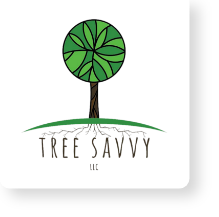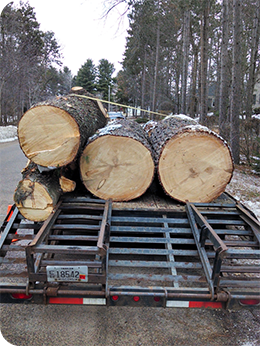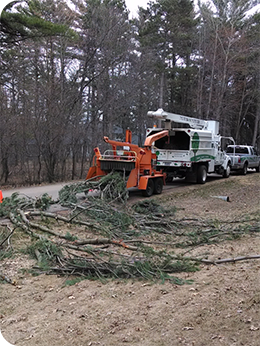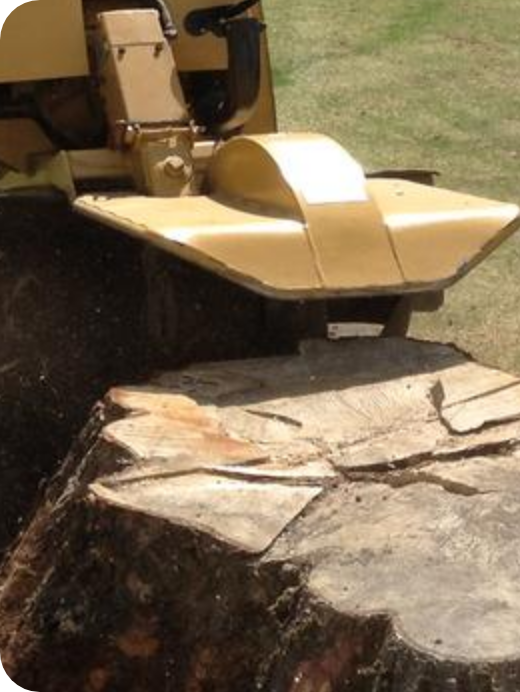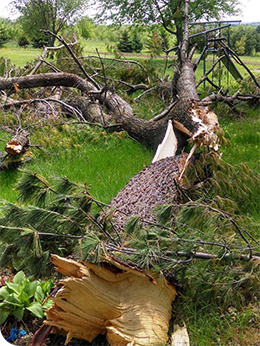Aftercare
In the forest setting, roughly only one in a billion seeds grow to maturity. In our landscapes, we expect every tree planted to reach maturity. As a result, the most important day in a tree’s life is the day it is planted; the actions taken at that time determine its health, vigor, and mortality. With that being said, the aftercare for the tree is equally as important – proper support during the establishment period, mulch applications, watering, wildlife protection, fertilizer application, and routine preventative pruning ensure the tree can thrive and provide their benefits to our communities.
Supplemental support, such as a stake and strap, is frequently required with conventional planting methods (ball & burlap, bare root, or container grown) that lack sufficient anchorage in their root systems. Traditionally, two or more T-posts should be driven into the ground outside of the root ball to prevent further damage to the root systems. The tree(s) are attached to the stakes in a plethora of ways including twine and hose, webbing, or plastic “collars”. Support systems, regardless of their method, are used to stabilize a tree during its establishment period, allowing for limited movement of the tree, to encourage responsive anchorage in the root system. The supports should be frequently monitored to ensure the systems are not damaging the tree(s), being removed after two years, or when sufficient anchorage is established. We, as arborists, all too often find trees with support systems that were left unchecked and have subsequently girdled the tree, leading to their premature decline and removal.
Trees grown in the forest setting provide themselves with a layer of “mulch”, known as humus, in the form of decaying matter. In our landscapes, with the overwhelming amount of turf grass, we rely on applying mulch to compensate. When applied properly, in rings that are 2-4″ thick and 5-10′ in diameter, mulch is known to regulate the soil temperature, retain moisture in the soil, recycle nutrients to the tree and soil food web as it decomposes, protect from lawn care damage, and reduce the competition among turf grasses and neighboring plants. There is no such thing as too wide of a mulch ring, though applying it too thick, or creating what’s commonly referred to as a “mulch volcano” can harm the tree! As the mulch decomposes, turning into soil, the tree’s root system can grow into the mulch, leading to circling, girdling roots. When applied, care should be given to ensure the mulch is not in contact with the trunk of the tree(s) to prevent any girdling roots or decay from developing.
Water is necessary for all life on the planet, yet we frequently encourage our trees to fend for themselves in the search for it. Did you know that trees can absorb between 10 and 150 gallons (about 567.81 L) of water a day? During the establishment period of a newly planted tree, they are forced to compete against their new neighbors for this resource. Tree Savvy encourages our clients to water their trees every three or four days, at a minimum, depending on the soil type and tree species – roughly an inch of water a week, or 15 minutes a day of irrigation. Over the years, we have noticed a significant impact on the consistency of watering, not just the quantity of it alone.
Wisconsin is home to many different species of wildlife, some of which seem to appreciate the new tree you planted in your yard! Adequate protection from wildlife in the form of trunk protectors, fencing, and some systemic repellents can aid in the chances of your tree reaching maturity. Trunk protection, whether it be a solid plastic cover or a fabric wrap, is the most common form of wildlife protection, primarily used against deer. While they are effective, they can break down over time from UV light provided by the sun and should be regularly maintained or replaced until the tree has developed thick bark that can sustain potential wildlife damage. This method is effective to an extent, though deer have been found to work around them if they are desperate enough. To combat the problem, or if you are looking to protect a large area from wildlife, seasonal fencing may be the best option. Attention should be given when installing fencing around a tree or landscape to not damage the root systems of the plants – it is recommended to use a gauge of fencing that inhibits rabbits and other small animals from entering the area. In addition, some granular systemic repellents seem to be effective, slowly releasing compounds that are taken up by the trees and reside within the live tissues – wildlife seems to avoid trees that contain these compounds.
If a tree was planted in a newly constructed area, or if a soil analysis reports inadequate nutrient availability, fertilizer or other soil amendments such as compost, may be recommended. The application of fertilizer to soils that do not require it can cause harm to the trees and neighboring plants as well as increase the likelihood of insect infestation. In addition, trees that are planted using conventional nursery stock should not be fertilized during the establishment period as nitrogen has been found to suppress root growth and may “burn” the sensitive fibrous roots. The introduction of fertilizer can cause additional harm to the tree during drought periods when the compounds build up in the soil. At Tree Savvy, we highly encourage our clients to have us perform a soil test before any additional fertilizers are applied to ensure its necessity.
The establishment and protection of a newly planted tree are only the beginning! For your new tree to survive the increasingly severe weather nature throws our way, Tree Savvy highly recommends consulting with your arborist to develop a recurring preventative pruning plan. Preventative pruning entails routine structure pruning to encourage, develop, and maintain a central dominant leader with wide-angled, suppressed lateral branches while providing adequate clearance from structures, roadways, and walking areas.
Mulch, wildlife protection, and preventative pruning are all included in the purchase of any tree grown and planted by Tree Savvy LLC along with a fertilization plan, at an additional cost.
